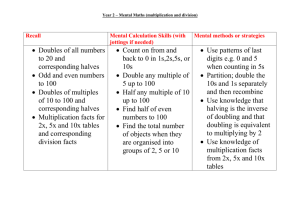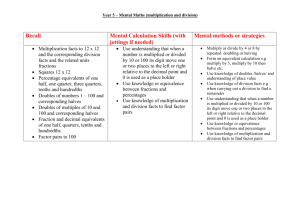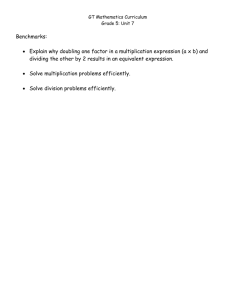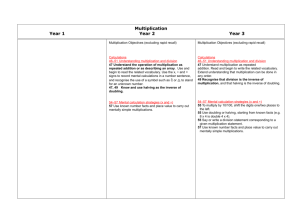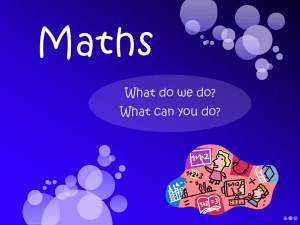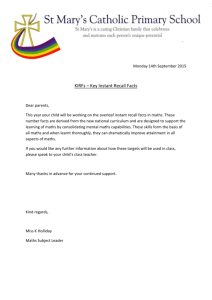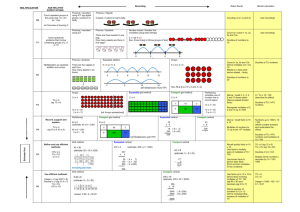How we teach multiplication
advertisement
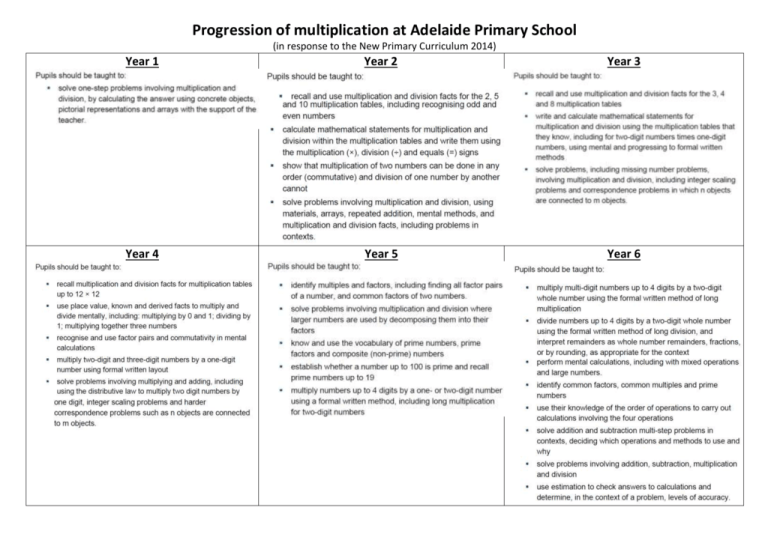
Progression of multiplication at Adelaide Primary School (in response to the New Primary Curriculum 2014) Year 1 Year 2 Year 3 Year 4 Year 5 Year 6 Foundation stage 22-36 months: 30 – 50 months: Compares two groups of objects, saying when they have the same number. 40-60+ months: Early Learning Goal: They solve problems, including doubling, halving and sharing. FSU 30 – 50 months: Early learning goal Compares two groups of objects, saying when they have the same number. They solve problems, including doubling, halving and sharing. Saw this maths game and really liked it Year 1 Concrete apparatus in arrays Double Multiplication is introduced. Children count repeated equal groups. Solve one step problems Children learn how to double and half amounts of objects. They learn all doubles to 5 off by heart. Count in 2s, 5s, 10s 4 4 4 Children learn to count in 2s, 5s and 10s off by heart. If there are 4 chips in one packet. How many are there in 3 packets? Year 2 Doubles and halves Multiplication as repeated groups, repeated jumps, repeated addition and arrays. Children learn how to find doubles and halves. They know that doubling is the inverse of halving. They learn doubles of numbers to 10 off by heart. Informal written methods Children make groups to calculate multiplications. They record the repeated addition underneath: Children show jumps on a number line. They can then move to just recording the repeated addition: Mental recall of facts They learn the 2, 5 and 10 times table facts by heart to the 12th multiple. Applying knowledge They understand the commutative rule. They sort multiples They show their understanding They solve problems Use of money (2p, 5p, 10p) really useful. Year 3 Mental recall of facts Informal written methods Review year 2 methods. Use practical and visual representations of arrays and jumps to develop understanding They learn the 3, 4 and 9 times table facts by heart to the 12th multiple. Other tips Using commutativity 4 x 12 x 5 = 4 x 5 x 12 = 20 x 12 = 240 Derive related facts (facts for free) 2x3=6 20 x 30 = 60 3x2=6 30 x 20 = 60 6÷3=2 60 ÷ 30 = 20 6÷2=3 60 ÷ 20 = 30 Formal written methods (short multiplication) Progressing (when children are ready) to efficient written method. Short multiplication. 4x3= Year 4 onwards Formal written methods Choose numbers carefully to begin with Can move to no brackets when ready Then move to carrying Year 6 moving to decimals Then move to larger numbers Useful web sites http://www.taw.org.uk/lic/itp/remainders.html - All National Strategy ITPs with explanations http://www.snappymaths.com/multiplication/earlymult/earlymult.htm - Really nice early multiplication resources for whiteboard and worksheets to print. http://www.iboard.co.uk/activities/page/2/subject/maths/years/4-7 - Really quality interactive games and demonstration tools
